Summary
- Buy 4 slabs of whole spareribs and trim to St. Louis style.
- Prepare the rub and apply to the ribs right before they go into the cooker.
- Cook at 225-250°F for 2 hours and baste with apple juice.
- Cook for another 2 hours, then begin checking for tenderness using the “tear test”.
- Continue cooking until tender, then apply barbecue sauce just before serving.
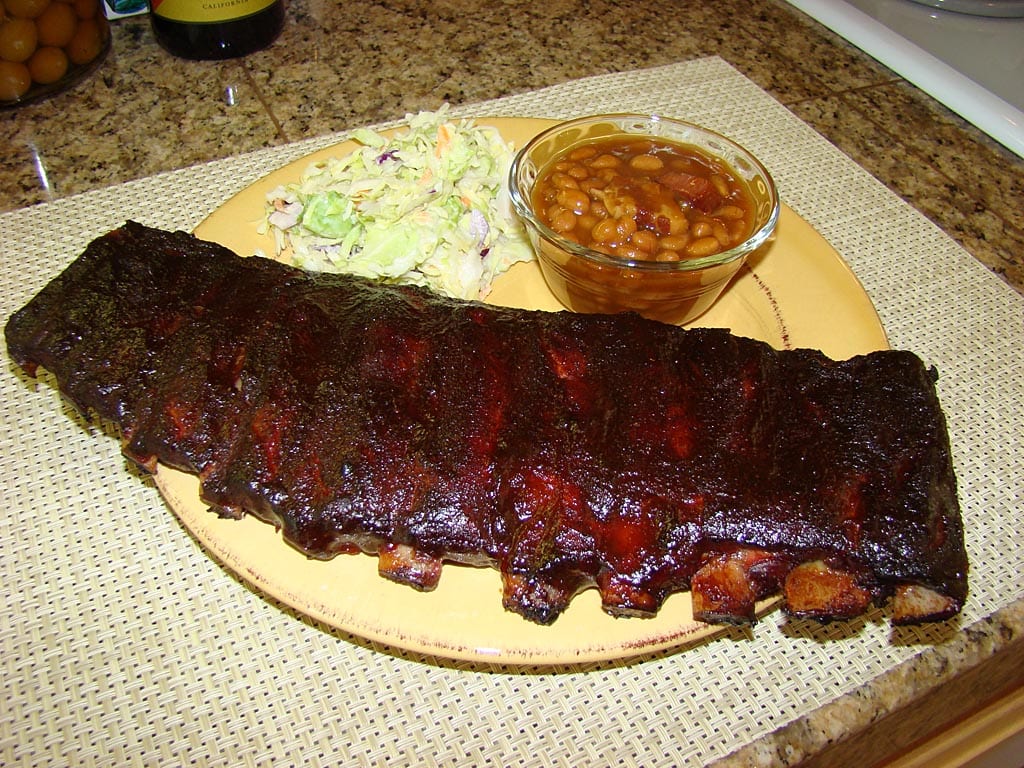 Spareribs are preferred by many people because of their meatiness and great pork flavor. They can be barbecued whole and untrimmed, or trimmed St. Louis style to resemble pork loin back ribs.
Spareribs are preferred by many people because of their meatiness and great pork flavor. They can be barbecued whole and untrimmed, or trimmed St. Louis style to resemble pork loin back ribs.
For these ribs, I trimmed them St. Louis style and used the “Sugarless Texas Sprinkle Barbecue Rub” from Paul Kirk’s Championship Barbecue Sauces, a wonderful book filled with tons of information and recipes for sauces, mops, marinades, and rubs.
Here are some pictures I took on May 20, 2007 when I prepared 4 slabs of spareribs using this rub.
Select And Prep The Spareribs
Purchase 4 slabs of whole spareribs averaging 3-1/2 to 4 pounds per slab. Trim them into St. Louis style spareribs yourself or have your butcher do it for you.
You’ll find information about selecting ribs in the Pork Rib Selection article. Detailed instructions, photos, and a video on trimming spareribs St. Louis style are found in the Pork Sparerib Preparation article.
I purchased 4 slabs of whole spareribs in Cryovac packaging, 2 slabs per package, from a wholesale foodservice store. The packages weighed 7.10 pounds and 7.65 pounds.
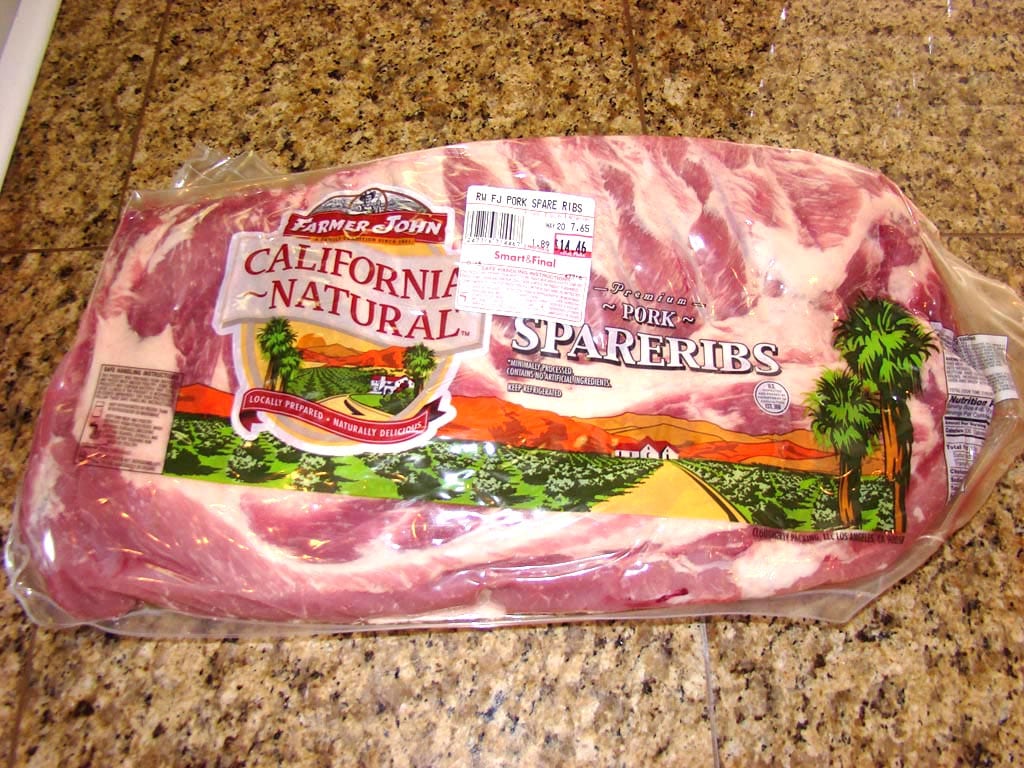
Each slab weighed about 2-1/2 pounds after trimming St. Louis style. Part of the trimming process included removing the membrane from the back of each slab.
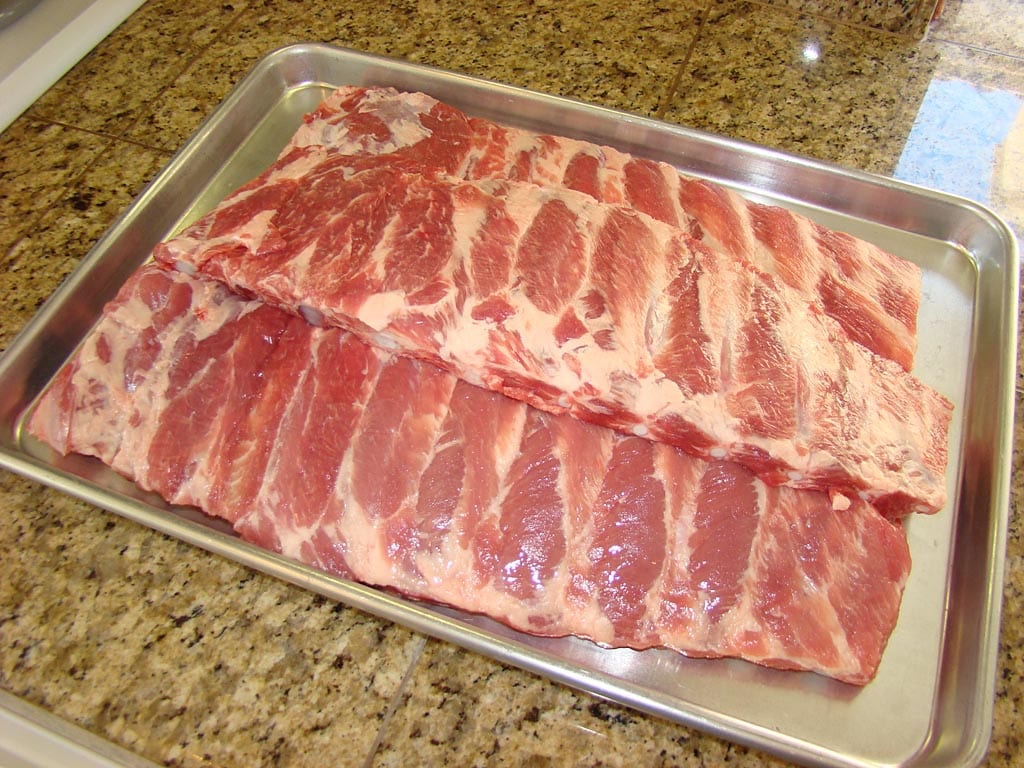
Prepare And Apply The Rub
Prepare a batch of Sugarless Texas Sprinkle Barbecue Rub. This will produce enough rub for 4 slabs of ribs with a lot left over.
If you’re sensitive to heat, you may want to cut down on the cayenne.
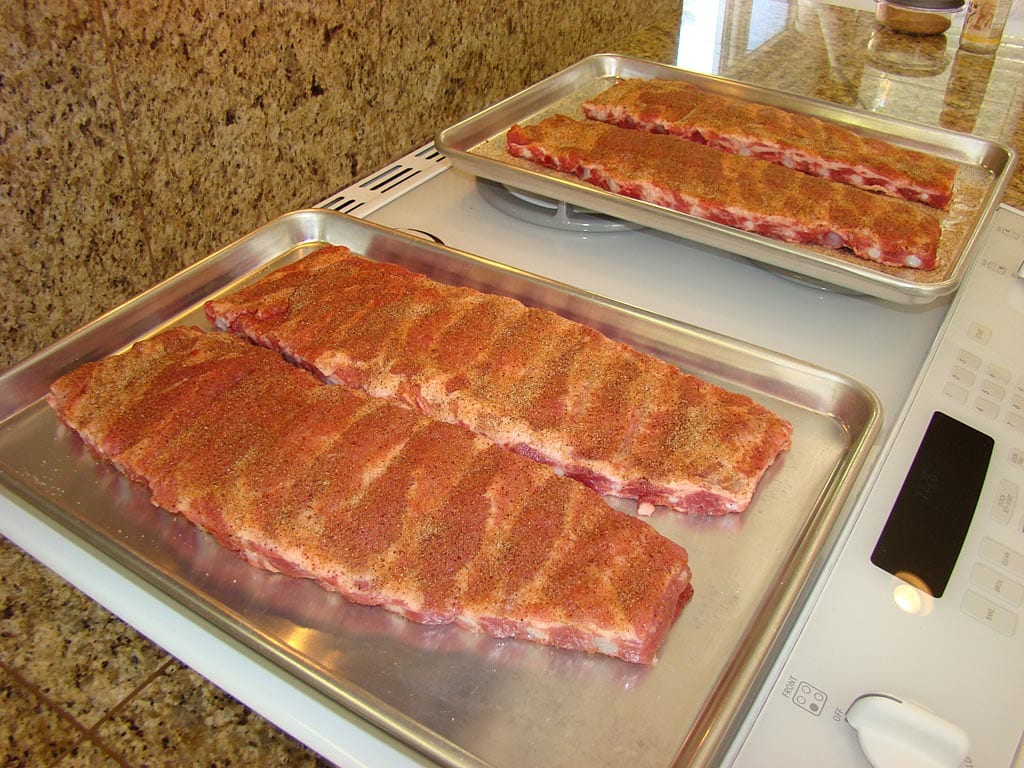
Sugarless Texas Sprinkle Barbecue Rub
- 1/3 cup table salt
- 1/4 cup paprika
- 3 Tablespoons chili powder
- 2 Tablespoons ground black pepper
- 1 Tablespoon ground cumin
- 1 Tablespoon granulated garlic powder
- 1 Tablespoon cayenne
Combine all ingredients and mix thoroughly. Makes about 1 cup.
Apply a heavy sprinkling of rub to both sides of the ribs just before putting them into the cooker.
Select The Smoke Wood
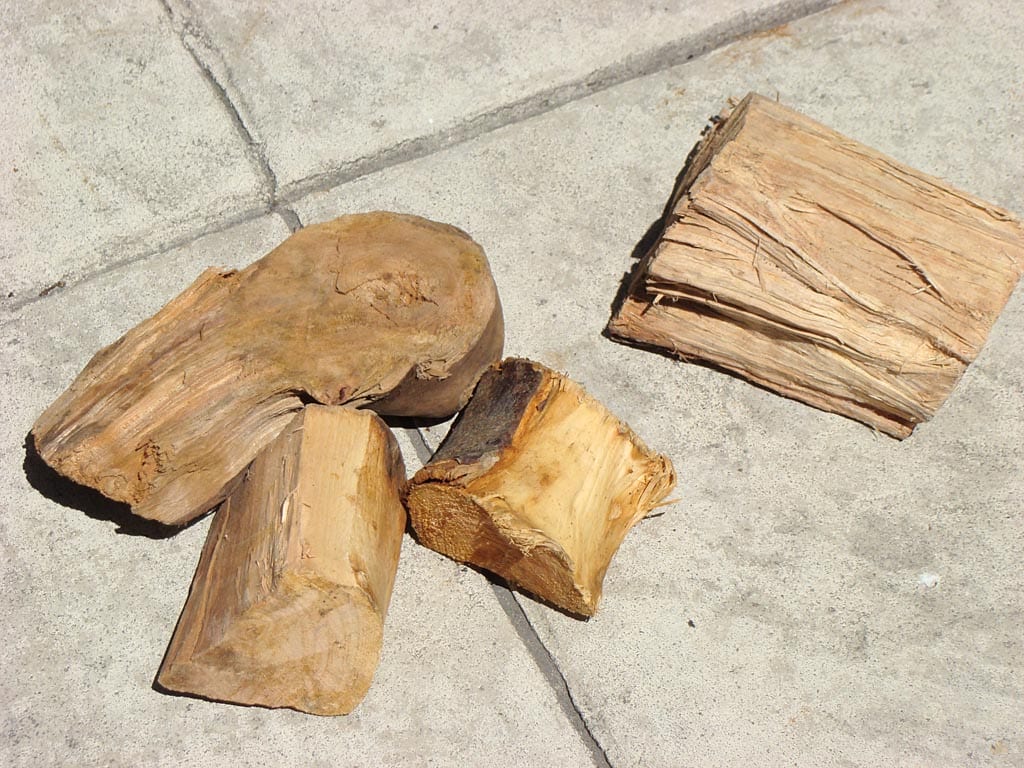 Use 4 chunks of apple smoke wood. Each chunk should be small, for example 3″ x 2″ x 2″ or similar. Cherry, oak, or another mild fruit wood can be used if apple is not available.
Use 4 chunks of apple smoke wood. Each chunk should be small, for example 3″ x 2″ x 2″ or similar. Cherry, oak, or another mild fruit wood can be used if apple is not available.
There is no need to soak the wood or remove the bark before use.
I used 3 chunks of apple and 1 chunk of cherry, as shown in this photo.
Fire-Up The WSM
Fire-up the cooker using the Minion Method. Fill the charcoal chamber 1/2 full with unlit Kingsford Charcoal Briquets, then light 20-40 briquettes using a Weber chimney starter and spread them over the unlit briquettes. Add the smoke wood on top of the lit coals.
Put the water pan in the cooker and fill it with cold tap water to help with temperature control.
Barbecue The Ribs
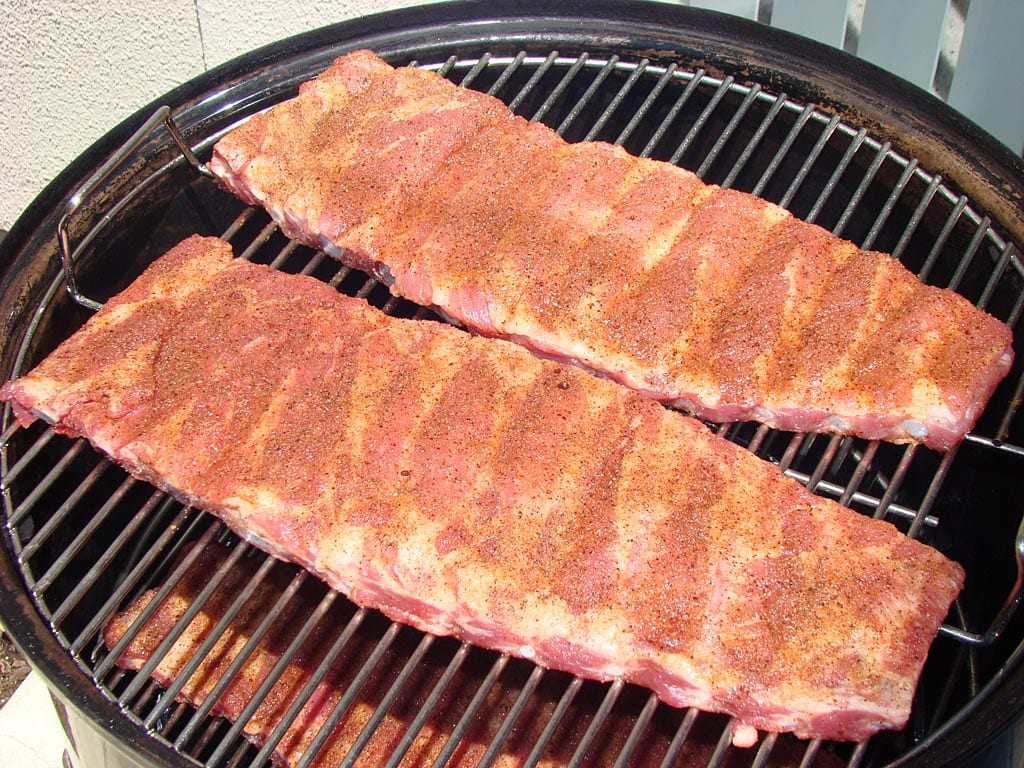 Assemble the cooker and put 2 slabs meat-side up on each cooking grate. Set the 3 bottom vents to 100% open. Open the top vent fully and leave it that way throughout the entire cook.
Assemble the cooker and put 2 slabs meat-side up on each cooking grate. Set the 3 bottom vents to 100% open. Open the top vent fully and leave it that way throughout the entire cook.
When the cooker reaches about 225°F, set the 3 bottom vents to 25% open so the cooker settles in at 225-250°F measured at the lid. Adjust the 3 bottom vents as necessary to maintain this temperature range throughout the cooking session.
Cook for 2 hours, then baste the meat side with apple juice using a spray bottle—I like Martinelli’s Premium Apple Juice.
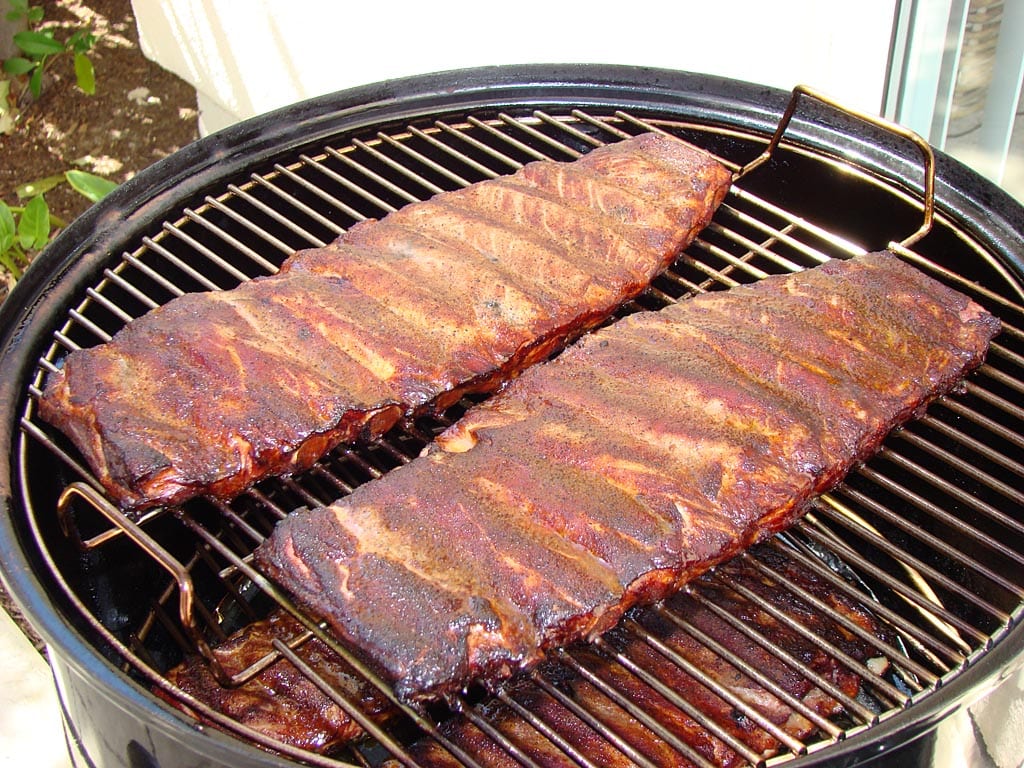
Cook for another 2 hours, baste again with apple juice, then begin to check for tenderness by using the “tear test”. Take hold of two adjacent bones toward the middle of the slab and give them a pull. If the meat offers a bit of resistance but then tears easily, you know the ribs are done just right.
If the ribs don’t pass the test at 4 hours—and they probably won’t—baste again with apple juice and cook for another 15 minutes, then test again. Repeat until the ribs are tender. Total cooking time for St. Louis style spareribs should be 4-6 hours, depending on the size of the ribs, number of slabs cooked, cooker temperature, and other variables. Let the “tear test” be your guide.
Note that some slabs may cook faster than others. If this happens, remove the done ribs from the cooker, wrap in aluminum foil, and place them in an empty cooler wrapped in towels to keep warm until the others are done.
There should be no need to add water to the pan during the cooking session.
Once all the slabs are tender, brush the meat side with your favorite barbecue sauce and cook 5 minutes, then sauce again and cook another 5 minutes.
Here’s how the cooker temperatures and vent settings went during my cook:
| Time | Lid Temp | Vent 1 % | Vent 2 % | Vent 3 % |
| 11:45 am | – | 100 | 100 | 100 |
| 12:00 pm | 208 | 100 | 100 | 100 |
| 12:20 pm | 255 | 25 | 25 | 25 |
| 12:30 pm | 248 | 25 | 25 | 25 |
| 1:00 pm | 248 | 25 | 25 | 25 |
| 1:30 pm | 246 | 25 | 25 | 25 |
| 2:00 pm (b) | 239 | 25 | 25 | 25 |
| 2:30 pm | 235 | 50 | 50 | 50 |
| 2:45 pm | 245 | 50 | 50 | 50 |
| 3:15 pm | 273 | 25 | 25 | 25 |
| 3:30 pm | 262 | 10 | 10 | 10 |
| 3:45 pm (b) | 256 | 10 | 10 | 10 |
| 4:00 pm | 247 | 10 | 10 | 10 |
| 4:15 pm | 240 | 10 | 10 | 10 |
(b) basted with apple juice
Note that the vent percentages represent the way I set the vents at the time indicated.
Good Eatin’!
Once the ribs pass the “tear test” and have been sauced, remove them from the cooker and enjoy immediately with your favorite side dishes.
This photo shows the finished ribs as they looked coming right out of the Weber Bullet.
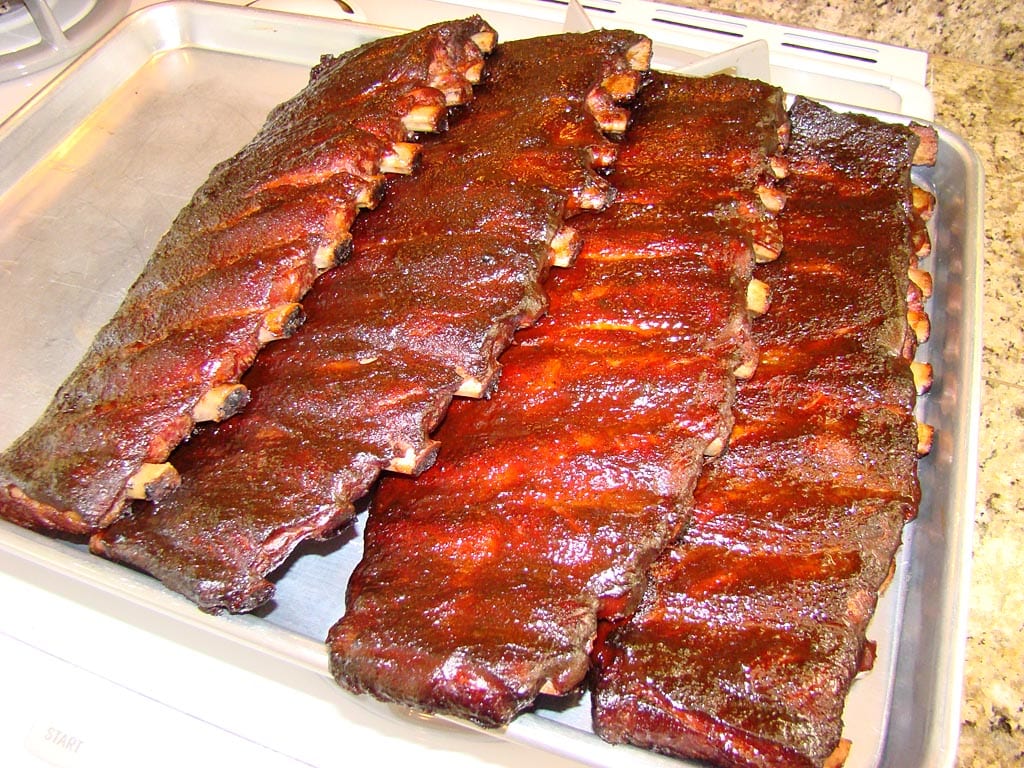
This photo shows a close-up view of how the meat pulled down along the bones.
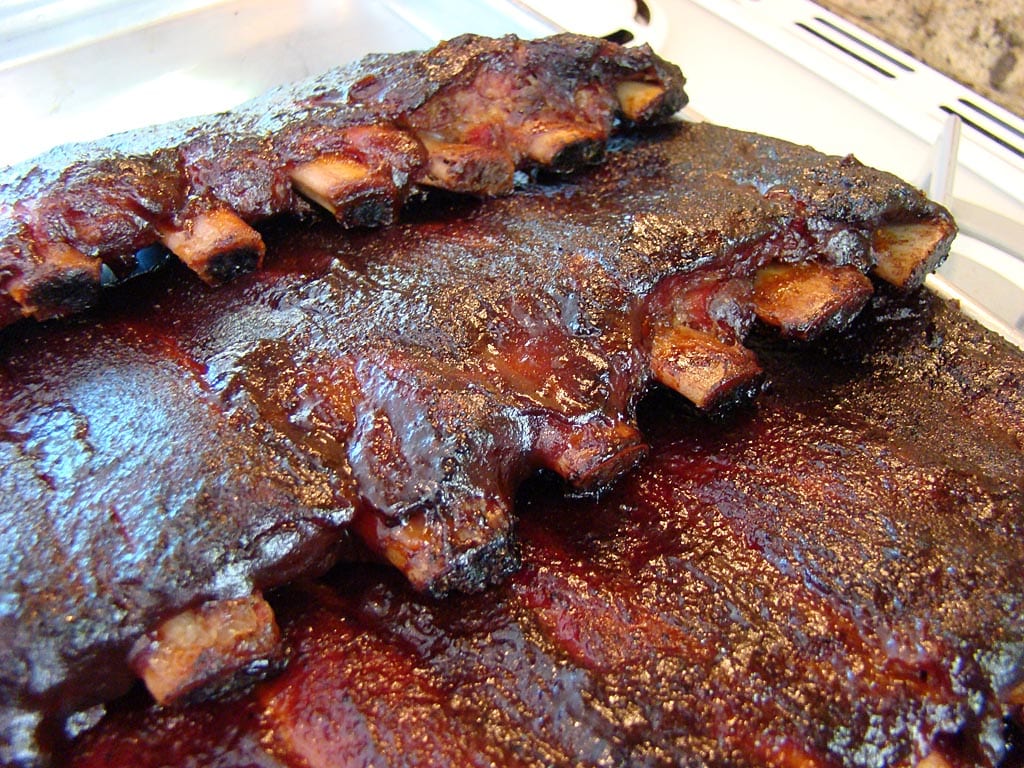
This photo shows the ribs served with coleslaw and baked beans.

More Pork Rib Links On TVWB
- Basic Baby Back Ribs
- Easy Baby Back Ribs
- Best Ribs In The Universe: Baby Back Ribs By The Legendary Mike Scrutchfield
- Baby Back Ribs – Dry Ribs
- Spareribs – 3-2-1 Method
- Rib Sandwich
- Pork Rib Selection
- Pork Loin Back Rib Preparation
- Pork Sparerib Preparation
 Don’t Boil Spareribs
Don’t Boil Spareribs
Many people are under the impression that spareribs benefit from parboiling before grilling or barbecuing. Nothing could be further from the truth! Parboiling toughens the meat and removes some of its flavor.
So save yourself the trouble…don’t boil ribs. Just trim any large areas of surface fat, remove the membrane from the bone side of the slab, apply your favorite rub, and put them straight in the cooker. Cook them “low and slow” and they’ll be nice and tender.






